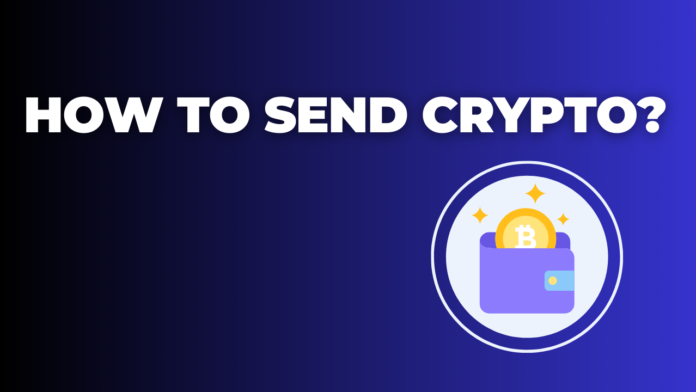Introduction
The use of cryptocurrencies has completely changed how to send crypto we conduct transactions by providing a decentralised, frequently speedier substitute for established financial institutions. We’ll go over the steps involved in transferring cryptocurrency in this article, making sure you understand them all and how to do it safely.
The use of cryptocurrencies has completely changed how we conduct transactions by providing a decentralised, frequently speedier substitute for established financial institutions. We’ll go over the steps involved in transferring cryptocurrency in this article, making sure you understand them all and how to do it safely.
What is a Cryptocurrency Transfer?
Transferring digital money between wallets is known as a bitcoin transfer. Cryptocurrency transfers are carried out on a blockchain, a decentralised register kept up to date by a network of computers, as opposed to traditional bank transactions, which make use of centralised financial institutions.

Why Use Digital Coins for Transactions?
Transfers of cryptocurrency provide a number of benefits:
- Speed: Regardless of location, transactions may be finished in a matter of minutes.
- Low Fees: Crypto transactions frequently have lower fees when compared to regular banking.
- Decentralisation: lowers the possibility of fraud and intervention since transactions are not managed by a single party.
Getting Ready to Send Bitcoins
Selecting a Wallet
To transmit bitcoin, you must first create a digital wallet. There are several varieties available:
- Hot Wallets: These are internet-connected digital wallets that facilitate regular transactions but may be more susceptible to hacking.
- Cold wallets: By storing your private keys offline, these offline wallets provide increased security.
Recognising Different Wallet Types
- Software Wallets: Computer or smartphone applications or web services that store and manage your cryptocurrency.
- Hardware wallets: Physical devices are tangible objects that are used to store secret keys off-line.
- Paper wallets: Printed documents are an easy-to-use yet safe solution to store cryptocurrency. They are printed papers that have your private and public keys.
Organising Your Wallet
To configure your wallet, take the following general actions:
- Download or Buy: Purchase the wallet’s hardware or software from a reliable vendor.
- Install and Setup: To install and set up your wallet, adhere to the provided instructions.
- Backup: To avoid losing access, make a copy of your wallet’s recovery phrase.
The Procedure for Sending
Obtaining the Address of the Recipient
You will need the recipient’s wallet address in order to send bitcoin. This wallet-specific string of characters is rather lengthy. To prevent mistakes, always double-check the address before sending.
Starting the Transfer
Get your wallet open: Open the wallet app on your phone.
- Input the Address of the Recipient: The wallet address of the receiver can be typed or pasted.
- Indicate the Amount: Enter the desired amount to send in bitcoin.
Verifying the Transfer Information
Verify the following again before completing the transfer:
- Make sure the recipient address corresponds to the desired location.
- Amount: Confirm the amount and kind of currency.
Finalising the Transfer
Verify the transaction after you’ve looked over the information. You might need to use a password or PIN to authenticate the transaction, depending on the wallet.
Times and Transaction Fees
The kind of cryptocurrency and network congestion affect transaction costs. The miners or validators who handle and validate the transaction are compensated for them. Look for the fee schedule in your wallet.
- Factors Affecting Transfer Time: Heavy Traffic Can Slow Down Transaction Processing on a Network.
- Transaction costs: Since miners give priority to transactions with higher costs, higher fees might speed up the process.
Protecting Your Private Keys Using Security Measures
In order to access your cryptocurrency, you must have your private keys. Maintain their safety by:
- Keeping Offline: Make use of encrypted backups or cold wallets.
- Refusing to Share: Keep your private keys to yourself at all times.

How to Spot Phishing Schemes
Scams that use hacking seek to obtain your login credentials or secret keys. Unsolicited emails or texts requesting private information should be avoided.
Having Two-Factor Authentication in Place
To increase security, turn on two-factor authentication (2FA) on your exchange and wallet accounts.
Fixing Typical Problems
Incomplete Transactions
Examine the following if a transaction fails:
- Accurate Address: Verify the address of the receiver is accurate.
- Network Status: Check to see whether the blockchain network is experiencing any problems.
Lost Money
In the event that you misplace your wallet, try:
- Recovery Phrase: To get access back, use your backup phrase.
- Support for Wallets: For assistance, get in touch with the wallet provider’s support staffs.
Delays in Transaction
Congestion on the network may cause delays. To find out if the transaction is pending, check its status using a blockchain explorer.
Rules and Legal Things to Think About
Legal Status of Transfers of Cryptocurrencies: Rules differ per nation. Make sure your bitcoin transactions comply with local regulations.
Tax Repercussions
Transactions using cryptocurrencies might have tax repercussions. To find out how these transactions impact your taxes, speak with a tax expert.
The Best Ways to Send Cryptocurrency and Double-Check Addresses
Prior to mailing, make sure the recipient’s address is correct. A minor mistake might cost you money.
Making Use of Reputable Services.
To reduce dangers, choose reputable wallets and exchangers with strong security protocols.
In summary
Once you know the essential processes and safeguards, sending bitcoin is a simple process. You can guarantee the security and efficiency of your transactions by selecting the appropriate wallet, double-checking information, and adhering to security best practices.
FAQs’
1.What is the duration required for sending cryptocurrency?
The amount of time varies based on network congestion and the coin. It may take several hours or just a few minutes.
2.What should I do if the address I transferred cryptocurrency to is incorrect?
Regretfully, there is no going back on transactions. To prevent such problems, double-check addresses before sending.
3. Are transactions using cryptocurrencies totally anonymous?
A public ledger records all transactions, even though they provide a certain level of privacy. Complete anonymity cannot be assured.
